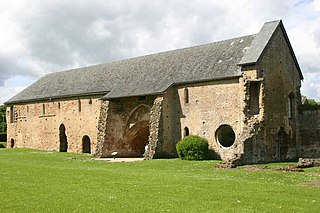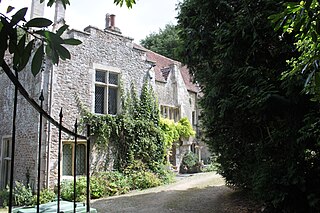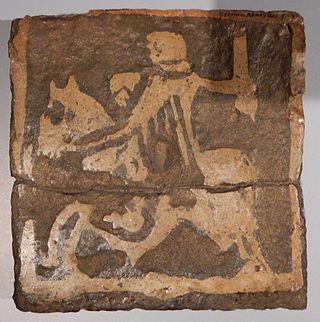
Faversham Abbey was a Cluniac style monastery [1] immediately to the north-east of the town of Faversham, in north Kent, England.

Faversham Abbey was a Cluniac style monastery [1] immediately to the north-east of the town of Faversham, in north Kent, England.
It was founded by King Stephen and his wife Matilda of Boulogne in 1148. [2] A party of monks from Bermondsey Abbey provided the nucleus and the first abbot.
At the Dissolution of the Monasteries, Sir Thomas Cheney assigned the abbey to Thomas Arden and it was considerably destroyed in 1538. Thereafter the site of the abbey came into the possession of the Sondes family [3] and now lies within the grounds of Queen Elizabeth's Grammar School.
The Abbey was the burial place of King Stephen, Queen Matilda, and their eldest son, Eustace IV of Boulogne. Their bones were reportedly thrown into the nearby Faversham Creek when the abbey was demolished. Their empty tombs were unearthed in 1964 near what had been the centre of the choir. However, there is a canopy tomb with no contemporary inscription in the nearby Parish Church, where it is said that their bones were re-interred.
The Abbey was excavated in 1965 by a team led by the archaeologist Brian Philp. [4] A full plan of the abbey was produced. At around 360 ft (110 m) in length, the abbey was shorter than Canterbury Cathedral, but longer than Rochester Cathedral. The cloister and monastic buildings were built on the northern side.

The abbey was built from a mix of chalk, flint, ragstone, greensand, and Caen stone. The roofing material appears to have been slate from south Devon with matches to materials obtained from sites near Modbury and Slapton Sands.
In May, 2019 Kent Archaeological Field School uncovered 150 ft (46 m) long by 50 ft (15 m) wide Roman building at Abbey Farm. According to the Dr Paul Wilkinson, the building contained broken stone walls. The walls covered huge amounts of box flue tiles, which were used to direct hot air up the indoor walls, glazed terracotta floors, an untouched underfloor with hypocaust heating and tons of ceramic roof tiles. Although the plaster painted from these walls were mostly white, plaster walls coloured with green, red and yellow panels were found in the hot sauna room on the north side of the building. The building was divided into two zones of activity – a bath house and a room for agricultural activity. [5]
Eustace IV ruled the County of Boulogne from 1146 until his death. He was the eldest son of King Stephen of England and Countess Matilda I of Boulogne. When his father seized the English throne on Henry I's death in 1135, he became heir apparent to the English throne but predeceased his father.

Faversham is a market town in Kent, England, 8 miles (13 km) from Sittingbourne, 48 miles (77 km) from London and 10 miles (16 km) from Canterbury, next to the Swale, a strip of sea separating mainland Kent from the Isle of Sheppey in the Thames Estuary. It is close to the A2, which follows an ancient British trackway which was used by the Romans and the Anglo-Saxons, and known as Watling Street. The name is of Old English origin, meaning "the metal-worker's village".

Smythe's Megalith, also known as the Warren Farm Chamber, was a chambered long barrow east of Blue Bell Hill, north of Maidstone, in the south-eastern English county of Kent, close to Aylesford village and the hamlet of Sandling.

Ely Cathedral, formally the Cathedral Church of the Holy and Undivided Trinity, is an Anglican cathedral in the city of Ely, Cambridgeshire, England.

Great Malvern Priory in Malvern, Worcestershire, England, was a Benedictine monastery and is now an Anglican parish church. In 1949 it was designated a Grade I listed building. It is a dominant building in the Great Malvern Conservation area. It has the largest display of 15th-century stained glass in England, as well as carved miserichords from the 15th and 16th century and the largest collection of medieval floor and wall tiles. In 1860 major restoration work was carried out by Sir George Gilbert Scott. It is also the venue for concerts and civic services.

Bordesley Abbey was a 12th-century Cistercian abbey near the town of Redditch, in Worcestershire, England.

Sawley Abbey was an abbey of Cistercian monks in the village of Sawley, Lancashire, in England. Created as a daughter-house of Newminster Abbey, it existed from 1149 until its dissolution in 1536, during the reign of King Henry VIII.

Dubris, also known as Portus Dubris and Dubrae, was a port in Roman Britain on the site of present-day Dover, Kent, England.

Tring Park Mansion or Mansion House, Tring Park, is a large country house in Tring, Hertfordshire. The house, as "Tring Park", was used, and from 1872 owned, by members of the Rothschild family from 1838 to 1945.

Cleeve Abbey is a medieval monastery located near the village of Washford, in Somerset, England. It is a Grade I listed building and has been scheduled as an ancient monument.

Faversham Stone Chapel also known as Our Lady of Elwarton, is a medieval chapel built on top of a Romano-British mausoleum. The chapel is located in what is thought to have been the Roman settlement of Durolevum, near the modern town of Faversham, in Kent, England. It is the only chapel in England known to incorporate the remains of an ancient shrine or mausoleum.

The Abbey, Beckington in Beckington, Somerset, England is a historic building that was founded as a monastic grange and also used as a college for priests; the building was begun in 1502, but after the Dissolution of the Monasteries it became a private house. It was altered in the early 17th century with a new front and a sumptuous barrel vaulted plaster ceiling, and also altered in the 19th century. The house was used as a school, restaurant and dance hall in 19th and 20th centuries but has now been restored as three houses: the most important plaster ceiling is in the house now known as "The Abbey".
The Northampton Abbey of St James was founded in Northampton in 1104–05 by William Peverel, as a house of Augustinian canons, and was dedicated to St James. William Peverel endowed it with some forty acres in nearby Duston, the church of Duston, and the parish's mill.

Coggeshall Abbey, situated south of the town of Coggeshall in Essex, was founded in 1140 by King Stephen of England and Matilda of Boulogne, as a Savigniac house but became Cistercian in 1147 upon the absorption of the order.

St Mark's Church is an ancient church on the north-east side of College Green, Bristol, England, built c. 1230. Better known to mediaeval and Tudor historians as the Gaunt's Chapel, it has also been known within Bristol since 1722 as the Lord Mayor's Chapel. It is one of only two churches in England privately owned and used for worship by a city corporation. The other is St Lawrence Jewry, London. It stands opposite St Augustine's Abbey, founded by a member of the Berkeley family of nearby Berkeley Castle, from which it was originally separated by the Abbey's burial ground, now called College Green. It was built as the chapel to the adjacent Gaunt's Hospital, now demolished, founded in 1220. Except for the west front, the church has been enclosed by later adjacent buildings, although the tower is still visible. The church contains some fine late gothic features and a collection of continental stained glass. It is designated by Historic England as a grade I listed building.

Hyde Abbey was a medieval Benedictine monastery just outside the walls of Winchester, Hampshire, England. It was dissolved and demolished in 1538 following various acts passed under King Henry VIII to dissolve monasteries and abbeys. The Abbey was once known to have housed the remains of King Alfred the Great, his son, King Edward the Elder, and his wife, Ealhswith. Following its dissolution these remains were lost; however, excavations of the Abbey and the surrounding area continue.

Queen Elizabeth's Grammar School is a selective co-educational grammar school with academy status in Faversham, Kent, southeast England. It was formed in 1967, when the Queen Elizabeth 1 Grammar School for Boys and the William Gibbs School for Girls merged and moved into new accommodation opposite.

Eynsham Abbey was a Benedictine monastery in Eynsham, Oxfordshire, in England between 1005 and 1538. King Æthelred allowed Æthelmær the Stout to found the abbey in 1005. There is some evidence that the abbey was built on the site of an earlier minster, probably founded in the 7th or 8th centuries. The site is a Scheduled Historic Monument.

Sandling is a hamlet to the north of the town of Maidstone, Kent, England, at the foot of the North Downs. It falls within the parish of Boxley.

The Keston Roman villa is an archaeological site in Keston in the London Borough of Bromley, England. The villa consisted of several buildings including a mausoleum. The latter is preserved above ground.